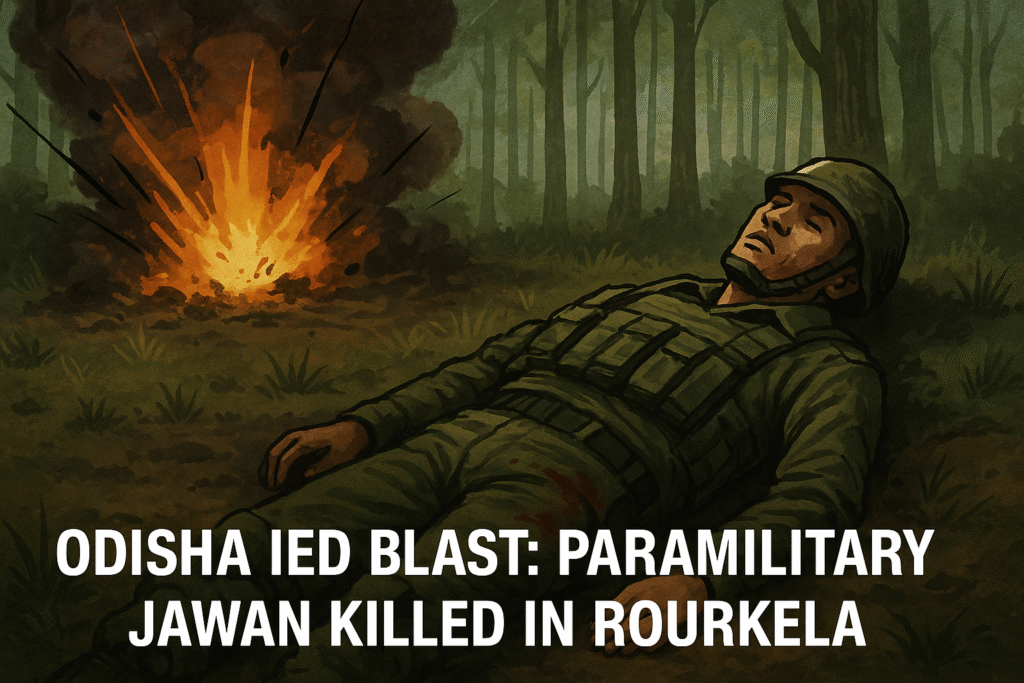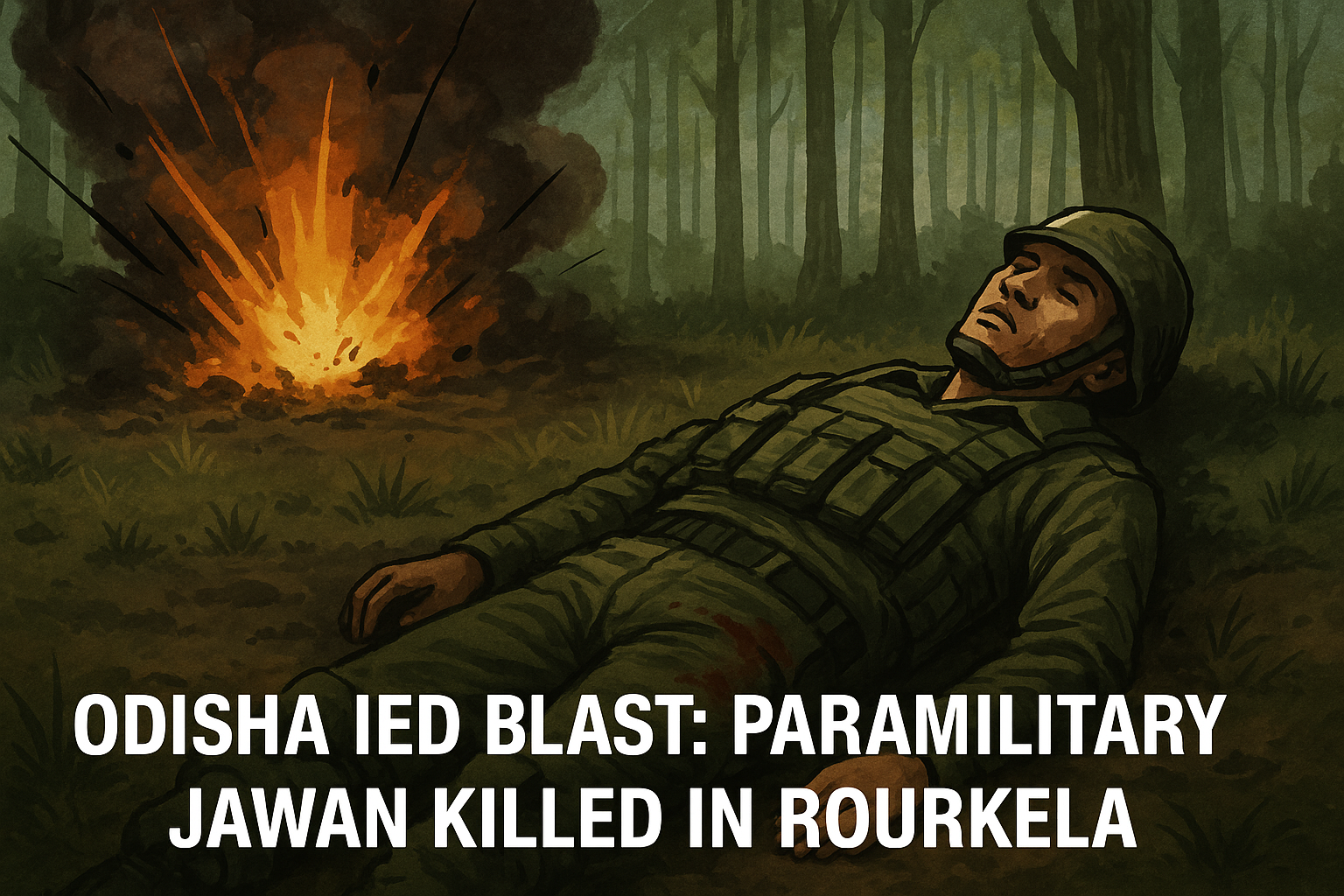
In a heart-wrenching turn of events, a Central Reserve Police Force (CRPF) officer lost his life in a tragic Odisha IED Blast during an anti-Naxal operation in the early hours of Saturday. The explosion occurred in the hostile terrain of the Saranda forest, West Singhbhum district, close to the volatile Jharkhand-Odisha border. This Odisha IED Blast has not only reignited concerns over Naxal insurgency in the region but also spotlighted the dangers faced by India’s paramilitary forces.
Details of the IED Blast
The Odisha IED Blast took place around 5:50 am in the K Baalang area near Rourkela, during a high-risk joint combing operation conducted by the CRPF’s 134 Battalion and Odisha’s elite Special Operations Group (SOG). The Saranda region, dense and inaccessible, has been under constant watch due to heightened Naxal activities in recent weeks.
Victim of the Odisha incident : ASI Satyaban Kumar Singh
The victim of the Odisha IED Blast, Assistant Sub-Inspector (ASI) Satyaban Kumar Singh, was a brave 34-year-old officer hailing from Kushinagar in Uttar Pradesh. The explosive device inflicted severe trauma on his leg. Despite prompt evacuation to Apollo Hospital in Rourkela, ASI Singh succumbed to his injuries shortly after arrival, making him the latest martyr of the ongoing anti-Naxal struggle.
Context Behind the Odisha IED Blast
The Odisha IED Blast follows a recent upsurge in Naxal activity, including a high-profile theft of explosives from a mining depot in West Singhbhum. Intelligence reports suggest the insurgents have increased surveillance on paramilitary movement, preparing ambushes like the Odisha IED Blast using guerrilla tactics to inflict casualties and instill fear.
Security officials believe the Odisha IED Blast was a calculated attack to derail counterinsurgency momentum in the area. It represents a chilling reminder of the sophisticated methods employed by Naxalites despite their low-tech weaponry.
Regional High Alert After the Odisha IED Blast
Following the Odisha IED Blast, security forces have enforced a red alert across the region. Reinforcements have been dispatched, and real-time aerial surveillance using drones has been intensified. Ground combing operations have expanded to cover a 30-kilometer radius, especially around possible Naxal hideouts.
The Odisha IED Blast also triggered emergency coordination among the CRPF, Odisha Police, and Jharkhand Police to assess insurgent threats and neutralize additional devices possibly planted along patrol routes.
Execution Modus of the Odisha IED
Initial investigations reveal that the Odisha IED Blast was triggered using a pressure-activated mechanism hidden along a known patrol trail. This reflects a classic Naxal tactic—using IEDs to surprise troops without engaging in direct combat. Such methods make each movement through dense forest areas perilous for security personnel.
The Odisha IED Blast occurred during a routine patrol aimed at sanitizing the terrain of insurgent presence and discovering new hideouts, underlining the constant danger faced during even standard operations.
Political and Strategic Response to the IED Blast
The Odisha IED Blast prompted strong reactions from political leaders, military officials, and civil society. Tributes poured in for ASI Singh, whose sacrifice is seen as emblematic of the risks India’s frontline forces endure in red corridor zones.
Security experts have called for a comprehensive technological upgrade for forces operating in insurgent-heavy regions. In response to the IED Blast, the Ministry of Home Affairs is reportedly considering measures such as:
- Deployment of mine-resistant vehicles
- Advanced IED detection gear
- Real-time satellite and drone surveillance
- Enhanced inter-state intelligence sharing
Intensified Combing After the IED Blast
The impact of the IED Blast has led to a significant increase in combing operations. Forest trails, suspected insurgent supply lines, and temporary hideouts are being scoured by joint forces, including the CoBRA unit (Commando Battalion for Resolute Action), India’s elite anti-Naxal strike team.
These teams are trained for high-risk terrains like Saranda, where the Odisha IED Blast occurred. Their mission is to neutralize any active threat and prevent similar attacks in the near future.
Civilian Fear After the Odisha IED Blast
The Odisha IED Blast has deeply unsettled local communities along the Jharkhand-Odisha border. Many residents fear retaliation from either side—insurgents or security forces—and have demanded increased security presence and civilian relief camps to avoid displacement.
Local panchayats and civil leaders are urging the government to provide trauma counseling, mobile medical aid, and food relief as a precautionary measure after the Odisha IED Blast.
Patterns of Violence
The Odisha IED Blast is part of a disturbing pattern of Naxal violence that relies on IEDs to destabilize regions and undermine state authority. Past incidents in Chhattisgarh, Maharashtra, and Jharkhand reflect a similar modus operandi, with explosives planted to target security forces on regular patrols.
This time, the Odisha IED Blast has raised questions over whether recent thefts of ammonium nitrate and detonators were used to prepare the bomb. Security analysts suspect the materials stolen just weeks ago were weaponized for this very attack.
Strategic Implications of the Odisha IED Blast
The Odisha IED Blast is likely to influence future counter-insurgency strategy in eastern India. National security planners are now pushing for real-time threat alerts, predictive patrol algorithms, and robust anti-IED training protocols.
Additionally, the Blast has exposed critical gaps in troop armor and medical evacuation infrastructure in conflict zones, areas that need urgent reform to safeguard personnel on the front lines.
Honoring ASI Satyaban Kumar Singh
In memory of the victim of the Odisha IED Blast, ASI Satyaban Kumar Singh is being posthumously honored for his courage and service. His remains were transported to his home district in Uttar Pradesh with full military honors. Memorial ceremonies and official condolences underscore the emotional toll of the Blast.
The CRPF has vowed to continue its operations with reinforced resolve, stating that no sacrifice will go in vain and that the Odisha IED Blast will only strengthen their commitment to eradicating insurgency.
Conclusion: The Odisha IED Blast and the Road Ahead
The Blast is a somber reminder of the ongoing challenges India faces in tackling Naxal extremism. It highlights the critical need for technological modernization, inter-state coordination, and support for frontline forces.
As the nation mourns the loss of ASI Satyaban Kumar Singh, the Odisha IED Blast must serve as a wake-up call for both policy reform and operational resilience. Every life lost in these hostile zones is a call to action—a reminder that the path to peace in Naxal-affected regions remains steep and fraught with danger.

One thought on “Odisha IED Blast: One Paramilitary Soldier Killed in Rourkela”
Comments are closed.